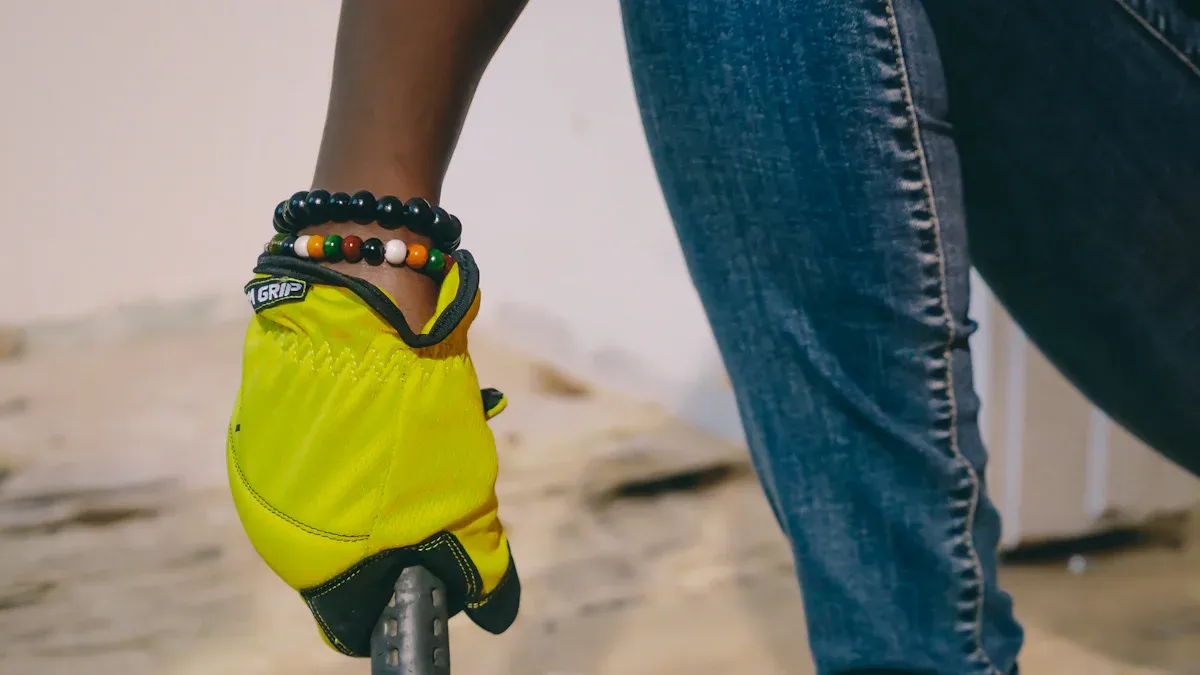
Wet sanding is a good way to take care of your wet sand bike frame. This method uses water and fine sandpaper to create a smooth surface. Many cyclists are concerned about sanding methods. They think that sanding can repair damage or clean frames, but this is not true. Some even worry that sanding could hurt their bike’s structure. Knowing the right way to do it can help you avoid these problems. It can also improve your bike’s look and strength.
Key Takeaways
Wet sanding makes your bike frame smoother. It helps it look shiny and professional.
This method makes less dust. It keeps your workspace clean and lowers health risks from breathing in particles.
Wet sanding gives you better control. You can work carefully and avoid hurting delicate materials like carbon fiber.
Using water while sanding keeps the surface cool. This prevents overheating and protects your bike frame.
Wet sanding helps paint stick better. This leads to a finish that lasts longer and makes your bike look better and stronger.
Better Finish

Wet sanding helps you get a smoother finish on your bike frame. This method uses water to help the sandpaper slide easily. This reduces scratches and makes a shiny surface. Here’s why wet sanding is special:
Faster Material Removal
When you wet sand, the water helps the sandpaper move smoothly. This means fewer visible scratches are left behind. Here are some important points to remember:
Water helps to smooth out sanding marks for a finer finish.
Wet sanding gives a smoother finish because of the water’s help.
This method is great for a shiny or mirror-like finish, perfect for bike frames.
Wet sanding also removes material faster than dry sanding. You can get your results quicker. This is helpful if you have many frames or are getting ready for a race.
To get the best results, pick the right grit sandpaper for your bike frame material. Here’s a quick reference table:
Bike Frame Material | Recommended Grit Sandpaper |
|---|---|
Aluminum | 220 grit |
Steel | 300 grit |
Carbon Fiber | 600 grit |
Using the right grit helps you remove flaws while getting the surface ready for paint. For a professional look, use 1000 grit sandpaper after 320 grit to fix any leftover scratches. Always clean the bike frame well to get rid of sanding dust before painting.
By wet sanding your bike frame, you make it look better and ensure a strong finish that lasts a long time.
Less Dust
Wet sanding your bike frame has a big plus: it makes less dust than dry sanding. This helps keep your workspace clean. You will enjoy sanding more without dust clouds around. You can focus on getting a smooth finish without the mess.
Tip: Keep a bucket of water close while sanding. This helps you keep the area clean and makes it easier.
Less dust is also better for your health. When you sand without water, tiny bits can fly into the air. Breathing these bits can hurt your lungs and throat. Wet sanding lowers this risk. The water catches the dust, stopping it from getting into your lungs. You can work on your bike frame knowing you are safe.
Also, a cleaner workspace helps you see your work better. You can find any flaws or scratches on your bike frame more easily. This lets you fix problems quickly, making sure you get a great finish.
More Control
Wet sanding gives you better control when working on your bike frame. This method lets you sand carefully, which is important for a perfect finish. The water helps the sandpaper move smoothly over the surface. This means fewer deep scratches or uneven spots. You can focus on certain areas without worrying about hurting nearby parts.
When you wet sand, you also lower the chance of damaging delicate materials. For example, carbon fiber bike frames need special care. If you sand too hard, you could damage the fibers. This can cause fraying or let moisture in. Both can weaken the frame and make it fail. Wet sanding helps you avoid these problems by being gentler. Here are some important points to remember:
Wet sanding keeps carbon fiber frames strong.
It lowers the chance of hurting the resin.
You can get a smooth finish without losing strength.
To show the benefits of wet sanding versus dry sanding, look at this table:
Sanding Method | Advantages | Disadvantages |
|---|---|---|
Wet Sanding | – Gives a smoother finish – Makes less dust – Stops overheating | – Messier process – Needs waterproof sandpaper |
Dry Sanding | – Faster cleanup – More flexible for different materials | – Creates more dust – May not give as fine a finish |
By choosing wet sanding, you have more control over the work. You can get a professional look while keeping your bike frame lasting longer. Avoid common mistakes, like putting on a clear coat too soon or using the wrong cleaners. These mistakes can cause poor sticking and a weaker finish. Always wait for the paint to dry fully before adding any topcoat.
With wet sanding, you can confidently fix your bike frame, knowing you are doing it right for a good result.
Enhanced Safety

Wet sanding your bike frame is much safer than dry sanding. One big benefit is that it lowers breathing risks. When you sand without water, tiny bits can fly into the air. Breathing these bits can hurt your lungs and throat. Wet sanding makes less dust, which keeps harmful bits from floating around. You can work on your bike frame knowing you are safe.
Another good thing about wet sanding is that it keeps the surface cooler. The water helps keep the temperature down. This reduces the chance of overheating. Overheating can harm sensitive bike frame materials, especially carbon fiber or aluminum. By using water, you keep your bike frame safe while sanding.
Wet sanding also makes handling materials safer. The water acts like a lubricant. This helps the sandpaper glide smoothly over the surface. It lowers the chance of deep scratches that can weaken the frame. You can focus on certain areas without worrying about hurting nearby parts.
Tip: Always wear protective gear, like gloves and goggles, when sanding. This extra safety helps protect your skin and eyes from splashes or debris.
Longer-Lasting Results
Wet sanding your bike frame makes it look better and helps it last longer. This method creates a strong bond between the frame and the paint. When you wet sand, you get rid of bumps and flaws on the surface. This gives you a smooth finish, which is important for the paint to stick well. A clean surface helps the paint hold on better, making it last longer than dry sanding or just cleaning.
Here are some key benefits of wet sanding for paint sticking:
Wet sanding makes a smoother surface, which helps paint stick on bike frames.
It removes bumps and flaws, leading to a stronger finish.
This method lowers the chance of hurting the material underneath.
Wet sanding stops dust and dirt from messing up the paint job.
After wet sanding, you can pick from different types of paint for your bike frame. Here’s a quick overview of common choices:
Type of Paint | Description | Notes |
|---|---|---|
Acrylic Enamel | Commonly used for auto paints, can be base coat, clear coat, or single stage. | Good for many uses, including bike frames. |
Known for being strong and often used in layers for a high-quality finish. | Gives a tough, long-lasting coating. | |
Lacquer | Less common for bike frames, may not be as strong as urethane options. | Dries quickly but may need more care. |
Oil-Based Enamel | Brands like Rustoleum and Valspar are in this group. | Needs careful mixing with hardeners for good results. |
2K SprayMax | A two-part system that gives high-quality results like powder coating. | Great for professional jobs. |
Polyurethane Enamel | Highly recommended for strength against wear and tear. | Gives a shiny finish that resists scratches. |
Base Coat/Clear Coat | Allows for different colors without thick edges. | Needs a matching clear coat to avoid lifting. |
By picking the right paint after wet sanding, you make sure your bike frame looks awesome and lasts a long time. This mix of wet sanding and good paint gives you a finish that can handle the challenges of cycling.
Wet sanding your bike frame has many good points. You get a smoother finish, make less dust, and have better control while working. This method is safer and helps your bike last longer. If you try wet sanding, you can make your bike care routine better. You will see a change in how your bike looks and how long it lasts. Start wet sanding today and enjoy having a well-kept bike!
FAQ
What is wet sanding?
Wet sanding is when you use water and fine sandpaper to make surfaces smooth. This method helps reduce scratches and dust. It is great for taking care of bike frames.
How often should I wet sand my bike frame?
You should wet sand your bike frame whenever you see any flaws or before you repaint it. Doing this regularly keeps your bike looking nice and working well.
Can I use any sandpaper for wet sanding?
No, you need to use waterproof sandpaper made for wet sanding. This kind of sandpaper works better when wet and gives a smoother finish.
Is wet sanding safe for all bike frame materials?
Yes, wet sanding is safe for most materials like aluminum, steel, and carbon fiber. It helps lower the chance of damage while making a smooth surface.
What should I do after wet sanding?
After wet sanding, clean the frame well to get rid of any leftover dust. Then, put on your chosen paint or finish for the best results.
See Also
Easy Methods to Safeguard Your Bicycle Frame
Proven Techniques to Eliminate Rust from Your Bike Frame
Crucial Tips for Protecting Your Bicycle Frame Effectively
Helpful Tips for Assembling a Dirt Bike Frame Kit
Guidelines for Caring and Maintaining Your Steel Bicycle Frame
